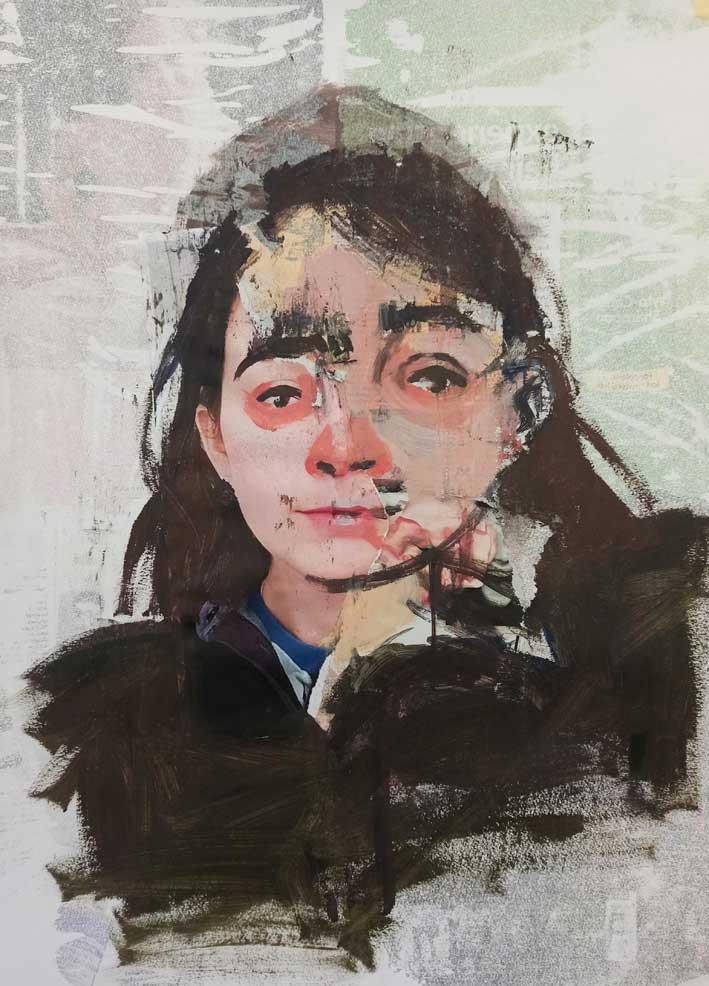Tell me what I know forms part of a joint exhibition entitled Strada Stretta Occupy by Students which is being held at the Società Dante Alighieri in Old Bakery Street and at The Splendid in Strada Stretta, both located in Valletta. The final work being presented by Marie Claire Farrugia is part of her M.A. dissertation in Fine Arts with the Department of Art and Art History at the University of Malta, under the supervision of Professor Giuseppe Schembri Bonaci.
This installation seeks to understand as well as to deal with truth and reality in relation to images, particularly images available online and on social media. This work seeks to manifest how social media images may be a form of post-truth in their complete disregard towards truth and reality. Imagery which has been edited or altered and which is being placed online is consumed by the public and in turn this is being converted into made-up forms of reality.
The term post-truth is being used to assess the current relationship individuals have with truth in today's contemporary world ruled by media images. The internet has become globally important in how one experiences the world and the environment for this relationship has turned into a highly charged one. Thus, this bond between the self and the image has been impacted in some way or another.

‘Décollage self-portrait’, mixed media on paper Image credit: Marie Claire Farrugia
The presence of post-truth imagery in everyday life, particularly social media, has in no way made the search for truth any easier. Despite all the information made available to the public, this age of truth and information, which was promised with the introduction of the internet, has never materialised. The internet now serves as a breeding ground that allows for lies to proliferate.
Despite the call to be oneself, niches are still prevalent more than ever, as humans still tend to agglomerate to people with similar beliefs. It is precisely this agglomeration that is so dangerous to truth. These bubbles of like-minded individuals create social cul-de-sacs in which other perceptions and ideas, different to one's own ideologies, go unheard of or ignored. Algorithms sieve the internet and its users in order to supply those same users with material that will attract them in order to distract and keep them engaged for longer, thus monetising their attention.
Post-truth is more than just alternative facts and fake news. It does not imply that there once was an age of truth and we are now in an age of lies. What is new now and what merits being called post-truth, is this laxness and apathy towards truth. The quest for truth has become anachronistic. Lying was always present, in all facets of life, not just politics or appearances. But what is novel is the change in reaction that is elicited once the lie is made apparent. The reaction is no longer anger. That anger and emotional chaos have now been tamed into acceptance and apathy.
The final work being presented in this exhibition can be broken into two main portions. The centrepiece exhibited stems from the myth of the Judgement of Paris. This myth is being used to serve as a commentary on the current relationship users have with social media, while the Pantone® swatch layout serves to highlight the misinformation that envelopes the public. Pantone® is a universal standard for colours and therefore in this work a lie is being told under the guise of an objective numeric standard. Through the use of periscopes, the viewer is invited to interact with the installation by directing the gaze onto different points of the work. In doing so, the work comments on the authorities' impact on perceptions. Finally, the trapezoid structure in which the viewer enters is a nod to Jeremy Bentham's Panopticon prison. The structure seeks to mimic a panopticon cell, in which prisoners self-correct their behaviour as they never know when they are being watched. Additionally, a number of studies are also being exhibited.
The hope is that this work will elicit some form of discussion surrounding our imagery, social media and the question of truth in our contemporary age. Finally, this work aims to highlight three major points; the way in which imagery is immediately consumed and its veracity not even questioned; the relationship between appearances in the physical world and how one edits their appearance online and finally the role and impact authorities play on public perception.
The works exhibited in Strada Stretta Occupy by Students can be found in two locations: Società Dante Alighieri in Old Bakery Street and The Splendid in Strada Stretta, Valletta. The works discussed here are exhibited at the Società Dante Alighieri.
The exhibition will be open until Thursday, 22 July. Opening times are Mondays to Thursdays between 6 and 9pm and Fridays and Saturdays from 7 to 11pm.
Strada Stretta Occupy by Students is organised by the Department of Art and Art History, University of Malta and The Strada Stretta Concept, as part of the Valletta Cultural Agency 2021 programme, in collaboration with the Società